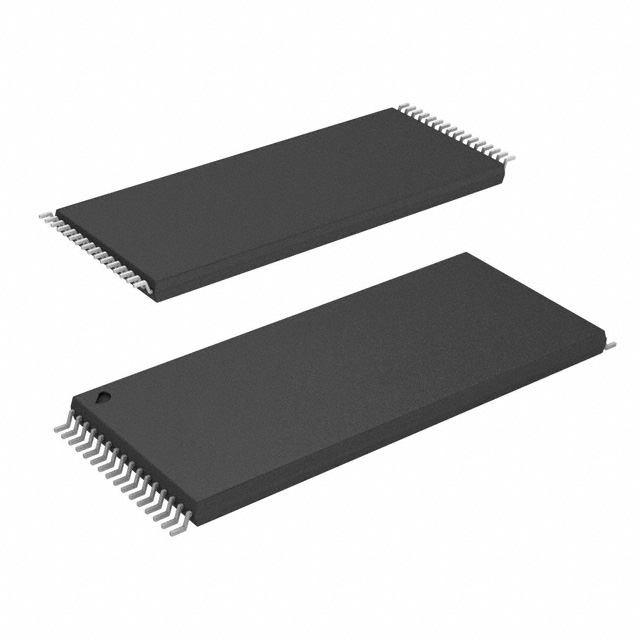AT29C020-12TC
Product Overview
Category: Integrated Circuit (IC)
Use: The AT29C020-12TC is a high-performance, low-power CMOS 2-megabit (256K x 8) electrically erasable programmable read-only memory (EEPROM). It is designed for use in various electronic devices that require non-volatile storage.
Characteristics: - High-performance CMOS technology - Low power consumption - Fast erase and write times - Wide operating voltage range - High reliability and endurance - Small form factor
Package: The AT29C020-12TC is available in a 32-lead Thin Shrink Small Outline Package (TSOP). This package offers excellent thermal performance and compact size, making it suitable for space-constrained applications.
Essence: The essence of the AT29C020-12TC lies in its ability to provide reliable and non-volatile storage for electronic devices. It allows for easy and efficient data storage and retrieval, enhancing the overall functionality of the devices it is used in.
Packaging/Quantity: The AT29C020-12TC is typically sold in reels or tubes, with a quantity of 250 units per reel/tube.
Specifications
- Memory Size: 2 megabits (256K x 8)
- Operating Voltage: 2.7V - 5.5V
- Access Time: 120 ns
- Erase/Write Cycles: 10,000 minimum
- Data Retention: 10 years minimum
- Operating Temperature Range: -40°C to +85°C
Pin Configuration
The AT29C020-12TC features a 32-pin configuration. Below is a detailed pinout description:
- A16 - Address Input
- A15 - Address Input
- A12 - Address Input
- A7 - Address Input
- A6 - Address Input
- A5 - Address Input
- A4 - Address Input
- A3 - Address Input
- A2 - Address Input
- A1 - Address Input
- A0 - Address Input
- VCC - Power Supply
- OE - Output Enable
- CE - Chip Enable
- WE - Write Enable
- I/O0 - Data Input/Output
- I/O1 - Data Input/Output
- I/O2 - Data Input/Output
- I/O3 - Data Input/Output
- I/O4 - Data Input/Output
- I/O5 - Data Input/Output
- I/O6 - Data Input/Output
- I/O7 - Data Input/Output
- NC - No Connection
- GND - Ground
- RP - Ready/Busy Output
- RESET - Reset Input
- WP - Write Protect Input
- A14 - Address Input
- A13 - Address Input
- A8 - Address Input
- A9 - Address Input
Functional Features
The AT29C020-12TC offers the following functional features:
- High-speed access: The low access time of 120 ns ensures fast data retrieval and storage.
- Easy integration: The IC can be easily integrated into various electronic devices due to its compact size and standard pin configuration.
- Low power consumption: The CMOS technology used in the AT29C020-12TC ensures minimal power consumption, making it suitable for battery-powered devices.
- Reliable data retention: The EEPROM provides a minimum data retention period of 10 years, ensuring long-term reliability of stored information.
- Versatile interface: The IC supports a wide range of input and output voltages, allowing for compatibility with different systems.
Advantages and Disadvantages
Advantages: - High-performance CMOS technology ensures fast access times. - Low power consumption extends battery life in portable devices. - Compact package size enables integration into space-constrained applications. - Reliable data retention ensures long-term storage reliability. - Versatile interface allows for compatibility with various systems.
Disadvantages: - Limited memory size (2 megabits) may not be sufficient for certain applications requiring larger storage capacity. - Erase/write cycles limited to 10,000 minimum, which may restrict frequent data modifications in some scenarios.
Working Principles
The AT29C020-12TC utilizes electrically erasable programmable read-only memory (EEPROM) technology. It stores data by trapping electrical charges within floating gate transistors. These charges can be erased or programmed using specific voltage levels applied to the control pins. When reading data, the stored charges are detected and converted back into digital information.
Detailed Application Field Plans
The AT29C020-12
Lista 10 Vanliga frågor och svar relaterade till tillämpningen av AT29C020-12TC i tekniska lösningar
Sure! Here are 10 common questions and answers related to the application of AT29C020-12TC in technical solutions:
Q: What is AT29C020-12TC? A: AT29C020-12TC is a specific model of EEPROM (Electrically Erasable Programmable Read-Only Memory) chip manufactured by Atmel.
Q: What is the capacity of AT29C020-12TC? A: The AT29C020-12TC has a capacity of 2 megabits, which is equivalent to 256 kilobytes.
Q: What does the "12TC" in AT29C020-12TC signify? A: The "12TC" represents the access time of the chip, which is 120 nanoseconds.
Q: What are some common applications of AT29C020-12TC? A: AT29C020-12TC is commonly used in various electronic devices such as microcontrollers, embedded systems, automotive electronics, and consumer electronics.
Q: How is AT29C020-12TC programmed? A: AT29C020-12TC can be programmed using a standard EEPROM programmer or through in-circuit programming methods.
Q: Can AT29C020-12TC be reprogrammed multiple times? A: Yes, AT29C020-12TC is an electrically erasable memory, which means it can be erased and reprogrammed multiple times.
Q: What is the operating voltage range for AT29C020-12TC? A: The operating voltage range for AT29C020-12TC is typically between 4.5V and 5.5V.
Q: Does AT29C020-12TC require any external components for operation? A: Yes, AT29C020-12TC requires a power supply, decoupling capacitors, and appropriate control signals for proper operation.
Q: What is the typical data retention period of AT29C020-12TC? A: The typical data retention period of AT29C020-12TC is around 10 years.
Q: Is AT29C020-12TC compatible with other EEPROM chips? A: Yes, AT29C020-12TC follows industry-standard pinout and communication protocols, making it compatible with other EEPROM chips with similar specifications.
Please note that these answers are general and may vary depending on specific application requirements and datasheet specifications.


